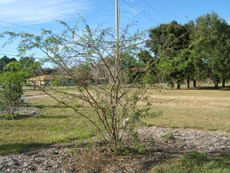Acacia farnesiana (Sweet Acacia)
*Click on picture for more images of this species.
- USDA Hardiness Zone: 8b - 11
- Mature Height: 20 to 40 ft
- Mature Spread: 20 to 30 ft
- Growth Rate: Medium
- Availability: Rare in large size, locally in small sizes
- Drought Tolerance: High
- Salt Tolerance: Moderate
- Light Requirements: Full sun
- Soil Drainage: Tolerates well-drained sites to occasionally wet sites
- Native Origin: Native to Florida
- Foliage: Semi-evergreen tree, with no showy fall color
- Flowers: Yellow, showy flowers year-round that have a pleasant smell.
- Pests: Free of serious pests and diseases. Occasionally anthracnose can infect leaves
Description: This semi evergreen, native small to medium-sized tree has feathery, finely divided leaflets of a soft, medium green color. The slightly rough stems are a rich chocolate brown or gray, possessing long, sharp, multiple thorns. The small, yellow, puff-like flowers are very fragrant and appear in clusters in late winter then sporadically after each new flush of growth, providing nearly year-round bloom. The persistent fruits have a glossy coat and contain seeds which are cherished by birds and other wildlife. It can be trained into a tree for use in median strips, or can be used as a street tree where there is not a need for tall-vehicle clearance beneath the crown.
The small stature and low, spreading branching habit makes pruning for vehicular clearance difficult unless it is properly trained from an early age. But the required input of man hours for early training may be offset by the high drought, pest and insect resistance of the tree. Do not locate the tree too close to where people can be injured by the sharp thorns on the branches, especially children. Although easy to grow in any acid or alkaline soil, including clay, the leaves will drop if the soil is allowed to dry out; this will not happen in most Florida landscapes due to frequent summer rain. This drought avoidance mechanism allows the plant to grow well with no irrigation once established.
Growing best in full sun, this thorny, well-branched shrub makes an excellent barrier planting or nesting cover for wildlife. When trained as a small tree and used as a freestanding specimen, it is likely to provide a source for comments, such as "what's that?".
Gainesville Observations: Trees partially defoliate in winter with some foliate remaining until spring. Retained foliage looks a bit "old" and not attractive by the spring. Sharp thorns on branches present a hugh challenge for using this tree in the landscape. Thorns make it difficult to plant, difficult to prune, and could pose a risk to people walking close to the tree. Acacia has grown fast in our plots and makes a nice wispy small to medium sized tree.


